On-demand webinar: The Partner Marketing Funnel: Introducing the 4 Why's
Partner marketing isn’t just about generating leads. It’s about moving opportunities through the funnel with clarity and purpose. Yet for many...
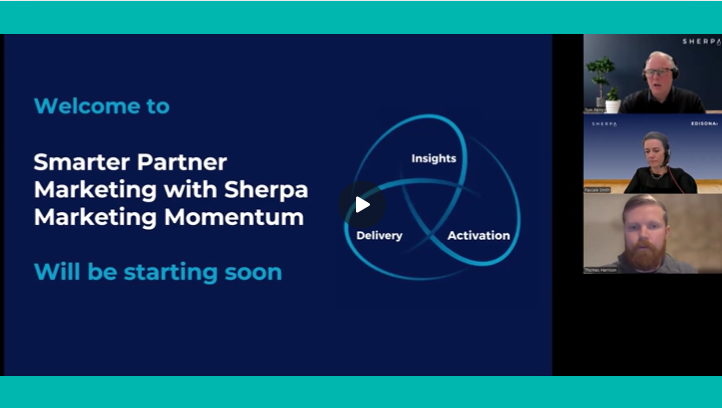
Below is a deep-dive into our new approach to Partner Marketing, Sherpa Marketing Momentum. Powered by our class leading AI platform targets the right Partners, with the right campaigns, and identifies future opportunities. Learning and optimizing with every program cycle.
In this webinar, we cover:
Hello, everybody. Good morning. Good afternoon. Good evening. Wherever you join us from in the world today. We are delighted to have you with us. My name is Tom Perry. I'm the founder and CEO of Sherpa, and I'm delighted today to be joined by Pascal Smith, who is our EVP of Strategy and together with Thomas, who is our Head of Marketing and our host today, we welcome you to our, our webinar on Smarter Partner Marketing and the launch of a new approach, we wanted to tell the world about our new approach called Sherpa Marketing Momentum.
A little bit before we get into, Sherpa Marketing Momentum and Sherpa. Over the course of a year, we've spoken to hundreds of technology companies from very large enterprises through mid market, a lot of scale ups and enterprise businesses. We identify, and, and hear from a lot of people and we can pinpoint trends that are happening in and around partner marketing.
And this is what is informing, the new product we're talking about today, how we go to market and how we've adapted ourselves from being quite a wide ranging, partnering agency into one that is beginning to concentrate and go much deeper into the partner marketing arena.
We think that there is a new model upon us. "Partner marketing has not changed much in the 30 or 40 years it's been around, the process, how we work with partners and how we think, it needs an overhaul." And, and we've used the trends that we see talking to people out and about to, to drive these.
If we look at what we're being told is the success drivers within partner marketing. First one is that everyone's looking to increase the performance of their partner marketing. There is more of a spotlight on the money in the investment that goes into it.
And it's incumbent, I think, to choose and prioritize the right partners to support with the right programs and the right activity and the right outcomes. At the end of the day, we're trying to drive marketing funnel ROI. That's our North Star here. And What you have to do in your businesses is also justify program investment.
People making investments, CFOs, whoever those people are funding, partnering organizations want assurances that their marketing investments are going to be used across this new diverse set of partners that we all encounter day in, day out, but is also coming back to driving ROI. And then we also speak to a lot of operators who are being asked around the structure and the scale of the programs.
If I get the structure of a program right, how can I then go on and scale it to drive faster revenue growth through partners? Operators we talk to want a fast pace to market, they want fit for purpose, scalable, repeatable, and ultimately measurable, campaigns that can be delivered across diverse partners.
But also people operating partner marketing programs share frustrations. And, and that the major frustration is about how to scale the programs. Do we talk to the same partners who are very adept at putting up their hand, the fastest coming to you with their discretionary requests or their MDF systemized requests and other ones that we know are always going to appear on the docket for support quarter over quarter.
Is that right? Or do we have tools now and content that can identify different partners? We know that there is a missing middle of partners where you can unlock true value in your partner organization by broadening your work before you engage with partners to identify the right partners.
And then you can unlock value and maybe further investment as, as we go by doing that work. And then we also see that, you know, partner. Teams and resources are challenged. They have been in the past year. We've we've seen, um, you know, part reductions in partner marketing teams. You know, it's a tricky environment, more types of partners, but more ecosystem led approach.
It's not the traditional channel anymore. And I think you need expertise in partner management in the right campaigns, the right data to, to really push things forward. And finally, just, just to leave you with this is we speak to a lot of vendors where you are not the only choice for partners. Now, the relationship has flipped itself around somewhat in the last two or three years where partners are being asked to sell more and more solutions.
They do a good job. They are at the coalface of those activities. And so, Does your partner marketing give you a competitive edge as you're delivering it today?
We'd like to show you a way of doing a far better job with a new model for partner marketing. We have spent, a year going very, very deep into what partner marketing means for our clients and the market as, as a whole.
We've come to the conclusion that there are three elements that need to be blended together and we describe these as insights, which is the data piece activation, which is having the right campaigns and also the delivery, which is the right people and team. Those three, bundled together, deliver an approach to partner marketing called Sherpa Marketing Momentum.
So that's just the scene setting for what we want to go on and show you. I'm going to hand over to Pascal now, who is going to talk about these three elements of insight, activation and delivery. Thanks, Tom.
If you wouldn't mind moving on to the next slide, Thomas, um, I want to talk about the insight piece first, and we use the word insight really intentionally because it's not just about data, but what does it tell us in terms of the action that we can take even before we've done any partner marketing activation?
And we use something called Edison AI campaign manager analysis, and it's a way to look at your partner ecosystem. In a, with leading metrics, metrics that describe their propensity for partner marketing success. And our Edison AI campaign manager analysis tool uses two key dimensions, a partner marketing success.
The first dimension is the skill of the partner. How much capacity do they have? How much capability do they have in the marketing arena? And that's on the X axis of the diagram that you can see there. So we look at partner marketing skill, but then we also look at how closely aligned those partners are with the campaign messaging itself.
So we use. AI to determine how aligned partners are. And that's on the Y axis. So when you plot the marketing skill with the alignment, it creates some clear segmentation. And that's segmentation that we can follow to understand which partners to invest in, but not only which partners, what kind of partner marketing activation they need to generate the most success.
So let me, tell you some examples. In, in the top of the top area of, of the scatter, you can see partners that score highest on alignment. These are the partners who are already marketing and selling around the same sort of message. You know, we call them either strategic marketing partners or specialist partners.
And we know that there's a real, The barrier for them to take campaign messages and deliver them to the end customer is going to be really successful because they're already doing it. They're already marketing around the same themes and topics. So we know that bringing the vendor technology and the partner specialism to the forefront is going to land really well with, with, um, end customers, if we go to the other end of the alignment scale, we've got groups of partners who aren't very aligned with, with your marketing messages, you know, Maybe we don't really want to be in market with those partners and we certainly don't want to prioritize them because they're not consistently marketing around the same, the same themes anyway.
So that's going to be a real challenge when it comes to partner adoption of the marketing program, but also their engagement with the leads. Now, for me, the really exciting part is, and Tom mentioned it before, is that missing middle. And those are the partners in the middle of the These are partners that You know, have alignment with the marketing message, but may not be the ones that come forward quarter on quarter.
You probably know who they are already. These are the partners who represent a really huge potential marketing scale for vendors and partners. In the, on the right hand side, we call them marketing ready partners. They're on average spending between 000 on their marketing infrastructure annually, and that marketing infrastructure is ready to go.
It's a great group of partners that we can pick up and run successful marketing with quickly. Partners on the left hand side of, of that, um, group, we call them sales ready partners. These are partners that don't necessarily have investment in their own marketing infrastructure. And so. It really gives us a sense of what kind of marketing is going to be really successful for them because if we were to run top of funnel lead generation activity with sales ready partners, that's going to be a challenge.
They don't have the automation. They don't have the tools to nurture leads into something that's ready for funnel. So we have to offer them something different. And I think for me, what this, this leading metric. Um, analysis does is it really exposes, um, a map, a map that we can follow that allows us to be proactive.
You know, often account teams are great at identifying sales partners, but we're taking a marketing lens here and we want to identify which kind of partners and how to activate them in the right kind of way, quarter on quarter. And so this map and Thomas, if you wouldn't mind moving on. So this map then aligns to what kind of program is right for which partners.
Um, so we classify programs in three different ways. We have, you know, programs that we call sales ready campaigns. They're ideal for partners who are quite aligned to the message, but have limited marketing capacity or infrastructure. In these campaigns, we run lead, you know, we do digital engagement activities into the target audience, but we also, um, have telephone.
Follow up and qualification. And those are leads that partners, sales teams can directly pick up. And we specifically choose partners that don't have marketing infrastructure to get these sorts of leads because they're much. More likely to turn into pipeline opportunities for marketing ready partners, we know they've got technology to support nurture.
Um, we know they've got marketing automation. So for these partners, you know, digital qualified leads are much better fit for these partners, because we know they'll be able to use their own infrastructure to turn these into opportunities that can go into their pipeline. And then for that top layer of strategic or specialist partners, the ones that are really aligned with the marketing message, you know, something like account based marketing is ideal for these sorts of partners because we know that they're already marketing around that same message.
So that vendor technology and data. Partner specialism coming together to land into a target list of, of companies is going to be really successful and really engaging for both the end customers and the partners. But the idea is that you use this sort of matrix of different marketing activation, but, you know, at the heart of it, you know, Exists, the campaigns that you've already set up, the kits that you're already utilizing, the technology and tools that you're already making available to partners, but really accelerating your ability to get that out in market and deliver the right activation, um, for the right kinds of partners with really, really different backgrounds.
We have two mechanisms of, of delivering these sorts of programs, uh, within our business. Thomas, if you wouldn't mind moving on.
One of those mechanisms is around delivering these kinds of campaigns with partners and the kind of support that partners need in order to really engage them, not only in the program itself, but ultimately in the leads that they generate. Um, and we run a lot of these programs with partner concierge and we call this with partner campaign execution.
And, um, And with this, we really support the partner in terms of them understanding a little bit more about the campaign, what their expectations are around delivering success. They get to, you know, choose their particular audience. Maybe that's an industry vertical that they're really successful in. We co brand the campaigns with the partners.
We include a little bit of referencing to their value proposition, and then we build and launch the campaign. But the partner comes along that journey too. We also support the partner throughout the execution. You know, did you follow up on the lead? How did it go? No. When's the next meeting, you know, and really kind of create that feedback of accountability and prioritization in the minds of the partners so that they're really engaged when those leads come in.
The other thing that we also do is deliver best practice for follow up for partners, whether they're getting sales. ready type leads, marketing ready type leads or ABM type leads. What is critical is the partners know how to follow up in the best practice to follow up. So we deliver all of this kind of enablement to the partner as the campaign runs.
Um, and for us, it's a really great way to not only tick a box in terms of, um, Partner marketing, um, funnel ROI, but also partner engagement and enablement. However, this doesn't scale across all businesses. So the other way in which we run these campaigns is doing it for partners where we're delivering, we're developing leads centrally, and those leads are rooted to the best fit partner, depending on where they sit in the Edison AI.
um, analysis map. But regardless of the mechanism by which we run the programs, um, there's something that sits at the heart of how we deliver, um, our programs. Thomas, if you wouldn't mind changing slides. Um, and that's how Those leads get delivered to partners. Um, we've seen a variety of different things.
It can be over email, it can be a Excel or a Google sheet that's updated, um, time and time again. But for us, that doesn't really represent what we're trying to achieve here, which is genuine partner engagement. Um, in both the program and the lead. So we deliver leads to partners across a lead delivery platform that's also in the Edison AI family.
And what this does is it acts as a digital destination point for the program. Partners can log in, they can see their leads, they can see details about their leads and give us feedback about the stage that that lead has progressed to. They can also view best practice material that we load onto the platform and it gives them a really great Um, experience from the program's perspective because they've got this digital and invested in, um, a destination.
But the great thing for us is we get to measure that engagement. We get to understand how quickly are those partners following up on leads? You know, which partners have given us feedback about leads? How are those leads progressing? We get all of this data. That really helps us understand not only the partner's engagement in the program, but also how they're engaged, engaging in the lead, because we have been doing partner marketing for so many years.
We know that there are two points of, of, of success and failure in, in partner marketing. One is that it's the right kind of lead going to the right partner. And most people focus just on that. But the second is how engaged those partners in following up those leads in the right. Way, and I don't think enough is done about this.
So we use this to ensure that we're covering both of those different elements to drive success.
So, Tom, do you have any further comments about, I wanted to quickly summarize our process. It's obviously quite involved and in depth, but hopefully that gives you a brief overview. Yeah, thank you, Pascal. And I think just to just to bring that together if we can move on one, Thomas, is that the the approach of Sherpa marketing?
Sorry, momentum. Just we have a look at an example of it is really very much around. leveraging data and insights, which, so it's not any more, um, field sales back in, sorry, feedback in on who we should be supporting. It's not, um, you know, a hunch. It is not whoever puts their hand up first. It's based on the partner's suitability for differing types of campaigns and their differing nature As partners, and so by taking a data driven approach within Sherpa marketing momentum, we are trying to drive genuine partner marketing funnel ROI with the right partners, the right campaigns supported by teams of people who are.
Absolutely get the partner environment and the nuances of managing multiple partners, and also giving that measurability and visibility that Pascal's just shown you with the Edison AI platform, which, which, you know, exists at the front of the process and throughout, and is giving that real insight that you can take back to the business and start to make the case for improving.
R. O. I. But also further investment and partners like this as well. We've seen numerous partners where we have been able to work with the vendor and go to them and say, we understand you're running a HubSpot environment. We understand you have four people on your marketing team. Here is A different type of campaign for you.
Now, some of that is known anecdotally, but when you see it in a data feed, it's very, very validating for the wider program that you're trying to scale. So the summary here is bringing data campaigns, the right people, the right process and visibility together, all as all in one, and that is Sherpa marketing momentum.
I'm going to hand back to Pascal who I'd like to take through a quick example, please. Absolutely. Um, so essentially there are five simple steps that we follow. Um, the first is, as I mentioned, we analyze that partner marketing environment. You know, our goal here is to invest in the right kinds of partner with the right kind of activities, and this provides the map for that investment.
The next stage is obviously the. of the campaigns themselves. In this example, you know, we selected four sales ready partners and four marketing ready partners to deliver campaigns with, this was a with partner marketing program. You know, we co branded the campaigns with the vendor and the partner. We offered the partner, the partner concierge support.
So they're really brought alongside the campaign and they're really invested in the campaign itself. Um, you The sales ready partners had digital marketing and telephone based qualification leads delivered to them. Whereas the marketing ready partners just had digitally marketing leads, um, delivered to them because we know they've got the technology infrastructure to be able to nurture those leads.
The third step. For us is, is during that execution, where we're really monitoring the partners engagement with the program, but engagement with the leads. Now, how quickly are they accepting leads? How quickly are they following up? What kind of feedback are they providing? Are they following best practice to ensure that they're.
you know, getting in touch with the part, with the prospects in the right kind of way that they've got the nurture workflow set up in the right way. This is all such a key part of driving that marketing funnel success. So we monitor it as the campaign goes along and we also monitor their Overall engagement with the program.
It's such a big part of that investment. You know, are these the right kind of partners to commit to an investment based on their engagement? And then that leads us to the, to the fourth step where we. Bring that data back into the Edison AI analysis. So we can highlight the partners that not only fit the right segment in terms of their marketing capability and alignment, but who are also engaged with the program and engaged with the lead in the right way, because those are the partners we want to invest in.
Again, we don't want to invest in partners who. You know, we're very gung ho and very excited at the beginning, but actually didn't really follow up the leads properly or didn't follow the best practice. So it gives us a real indication of who to invest in again. And we take that continuous learning, um, for the final step, which helps us to then optimize the ROI quarter on quarter.
And that's the cyclical nature, um, that, um, Tom described. And for us, you know, an initial quarter ROI would be, Around, you know, 1 spent to 18 achieved in marketing funnel ROI in this example. And so you can see that this iterative optimization process is about generating partner engagement. It's about generating marketing funnel ROI from the leads.
It's about having a scalable, repeatable cyclical pro program that's repeated and optimized again and again, but ultimately uses all of the materials that vendors are already creating for partners. And it's just delivering the right kind of program to the right partners. All right. Thank you very much.
And I think that's a kind of global. CX software company you're seeing in action there, but redacted for obvious reasons. But this, this is live. And if, and if you do want to understand some more use cases that might be more pertinent to, to, to what your business is up to, please, please do shout out. We have, we have numerous of these we built up over the last year.
So just before we wrap up, we had a couple of questions in, um, and one goes right back to the Pascoe, you talked about sales ready, marketing ready, you know, type of campaigns and activation. And, um, we had one from Samara at A10 Networks who says, you know, is, she's curious as whether partner ABM is, is working for anybody.
And I think, you know, Um, I don't mind handling that, but we have made a deliberate decision to put partner ABM into our catalogue of, you know, campaigns that we offer, because it is so pertinent for that top rung of the Edison analysis that Pascal showed us right at the beginning. ABM is more verticalised, it's more involved, there is more data work, it is more with partners most definitely shoulder to shoulder.
It tends to be used for strategic specialists, certainly features in GSI, um, and at the larger end of service partners. And I think that's, that, that, that tried to deal with that question. The other question we have is, is really around from, um, Sophia at Nokia, which was, I'm working with different types of partners.
I'm moving from channel only to ecosystems and hyperscalers. Pascal, maybe you could handle, you know, maybe just describe for us briefly the sort of agnostic nature of, of Sherpa marketing momentum. I think at the end of the day, um, a lot of vendors, you know, start to categorize or in fact, even de categorize what kind of partners they have, but ultimately from a partner marketing lens, those two axes of, are they aligned?
To the message that we want to deliver with the partner in the market. And what is their skill to do that is, is true no matter what kind of, of partner it is, whether it's a hyperscaler, a GSI, a systems integrator, a reseller, or an even, even an influencer, are we talking about the same type of message in the market alignment, and what's your ability to get that message out to your end customers?
So. I think for taking a marketing lens at this actually, you know, reduces the need for a categorization of, of partners. And then that comes down to, well, how much do you invest in your GSIs versus your influencers versus your, your kind of reseller or traditional reseller market? So I think the analysis and the kind of programs that we, that that analysis indicates still are the same.
Um, and we run them across loads of different types of partners because, you know, ultimately. The measurement of, of success from, from partner marketing is marketing funnel ROI and pipeline and sales at the end of the day. So I don't think much changes with that process, Tom. All right. Thank you. It's a great answer.
And so just to wrap up, um, we did have one other question, which was from Meredith object first, and it was what programs, you know, should I try and avoid and and hopefully we've been able to give you an indication of what programs ones that are not data backed ones that do not have the right campaign for the right partner ones that are not measured and visible and drive ROI would be the answer on that one.
But hopefully we've given Um, And Pascal, should I go on? Yeah, just to add to that, I mean, we've all run those programs, right? Where we've developed leads, we've generated leads, we've used content syndication and things like that, and we've generated leads and we haven't seen the ROI. I think, you know, as Tom said, doing that with the data backing gives us the confidence that actually we're going to see a consistent marketing funnel ROI.
So consistency around that is, is the kind of programs we should be investing in. Okay, thank you very much. So, um, without further ado, thank you so much for joining us today. We will follow up. Um, we have an on demand copy. We have a benchmark report around partner marketing and ecosystem, um, that, uh, has been out in the world, but please take a look at that.
Um, and we will be sending out a survey. And finally, for me to say that, um, we, we do have the ability to assess. Partner marketing ecosystems very, very quickly, and if you would like us to undertake a free assessment of any group of partners or within your ecosystem or your community, please do let us know.
Thank you very much. Please take care and thank you for joining us. Bye bye.
.jpeg)
Partner marketing isn’t just about generating leads. It’s about moving opportunities through the funnel with clarity and purpose. Yet for many...
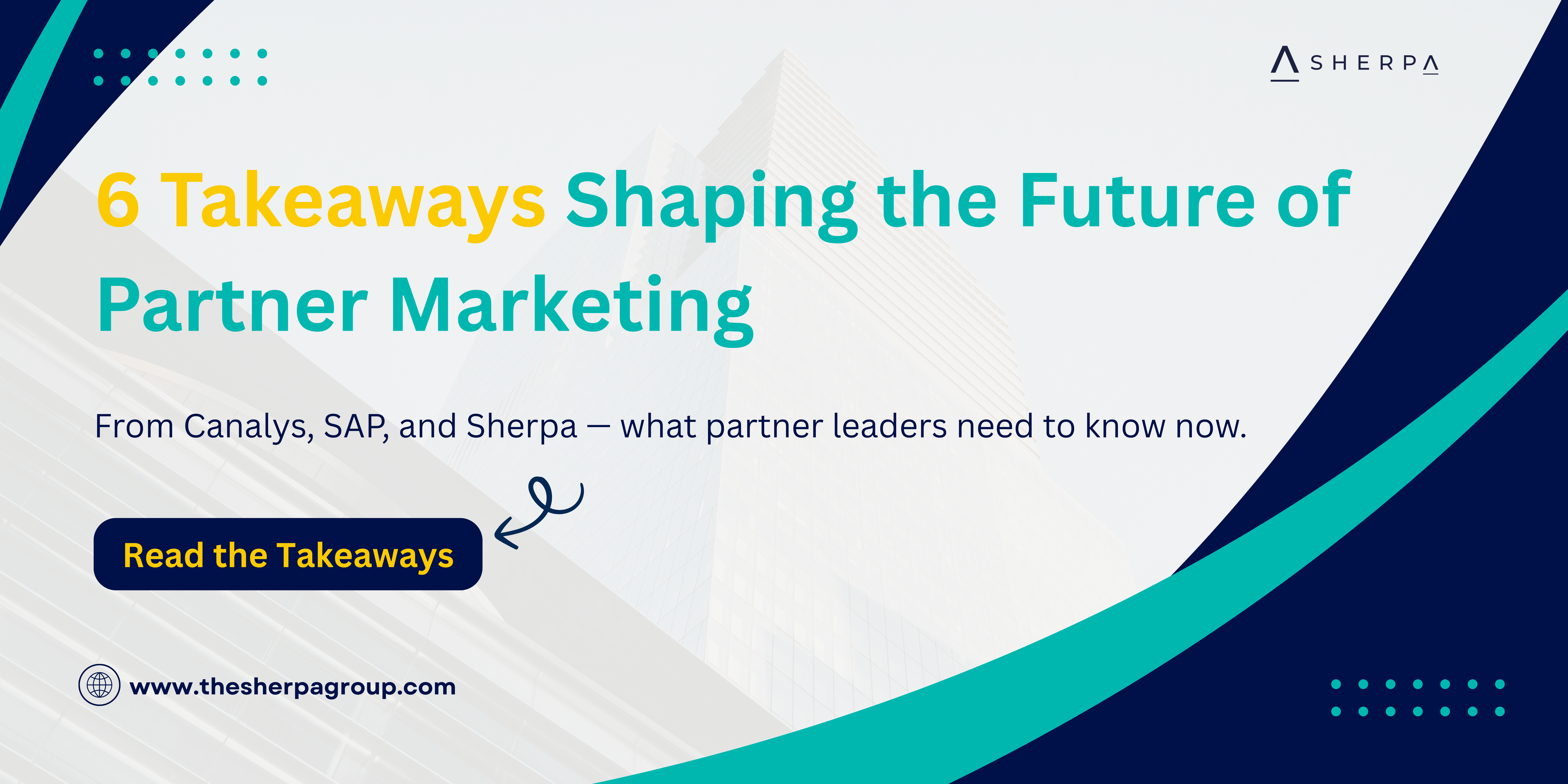
Partner marketing is entering a new era.
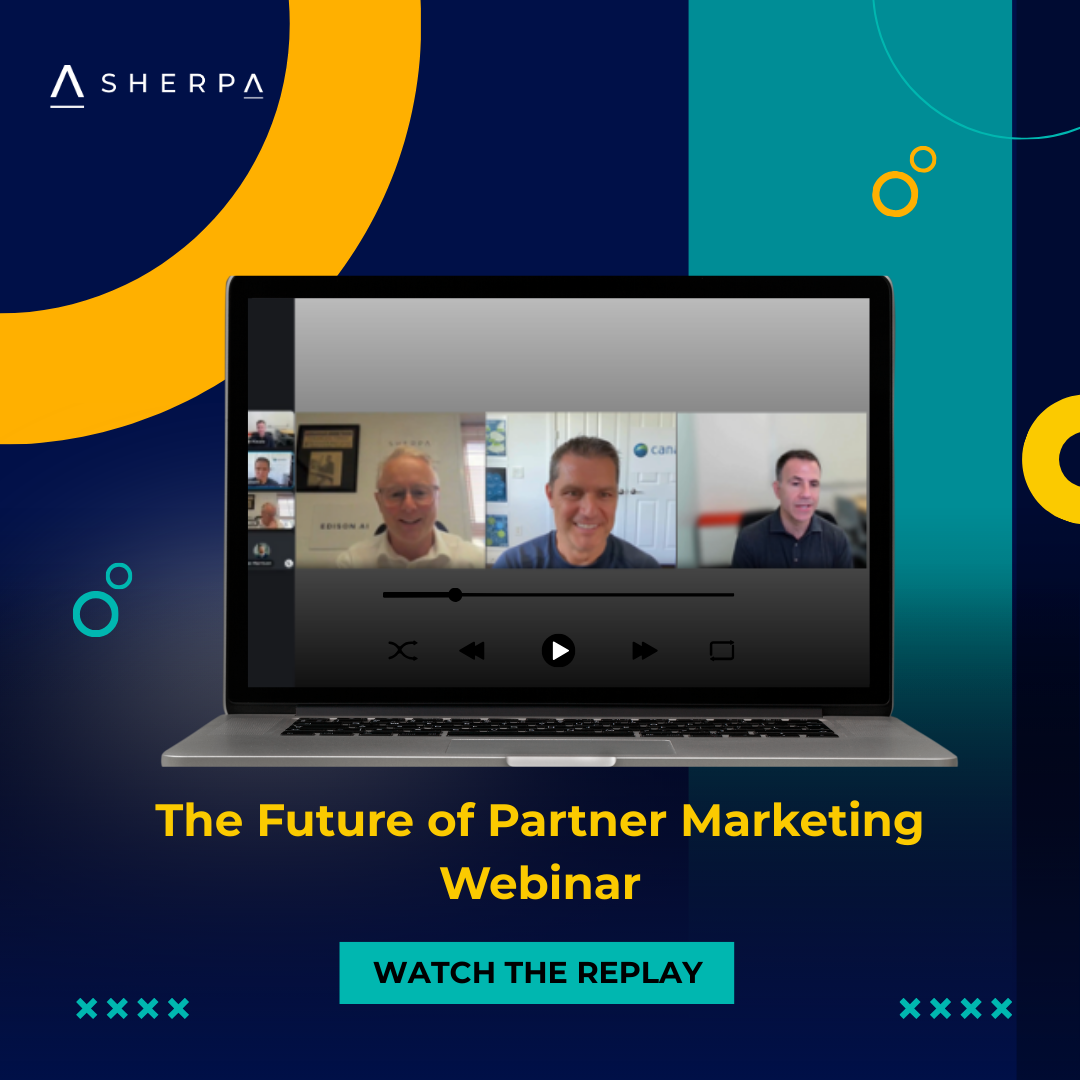
Partner marketing isn’t just evolving, it’s accelerating. With buying committees now stretching to 20+ decision-makers, AI reshaping how we work, and...

In the dynamic realm of Partner Marketing, staying ahead requires innovation. At Sherpa, we're committed to leading the charge with our cutting-edge...
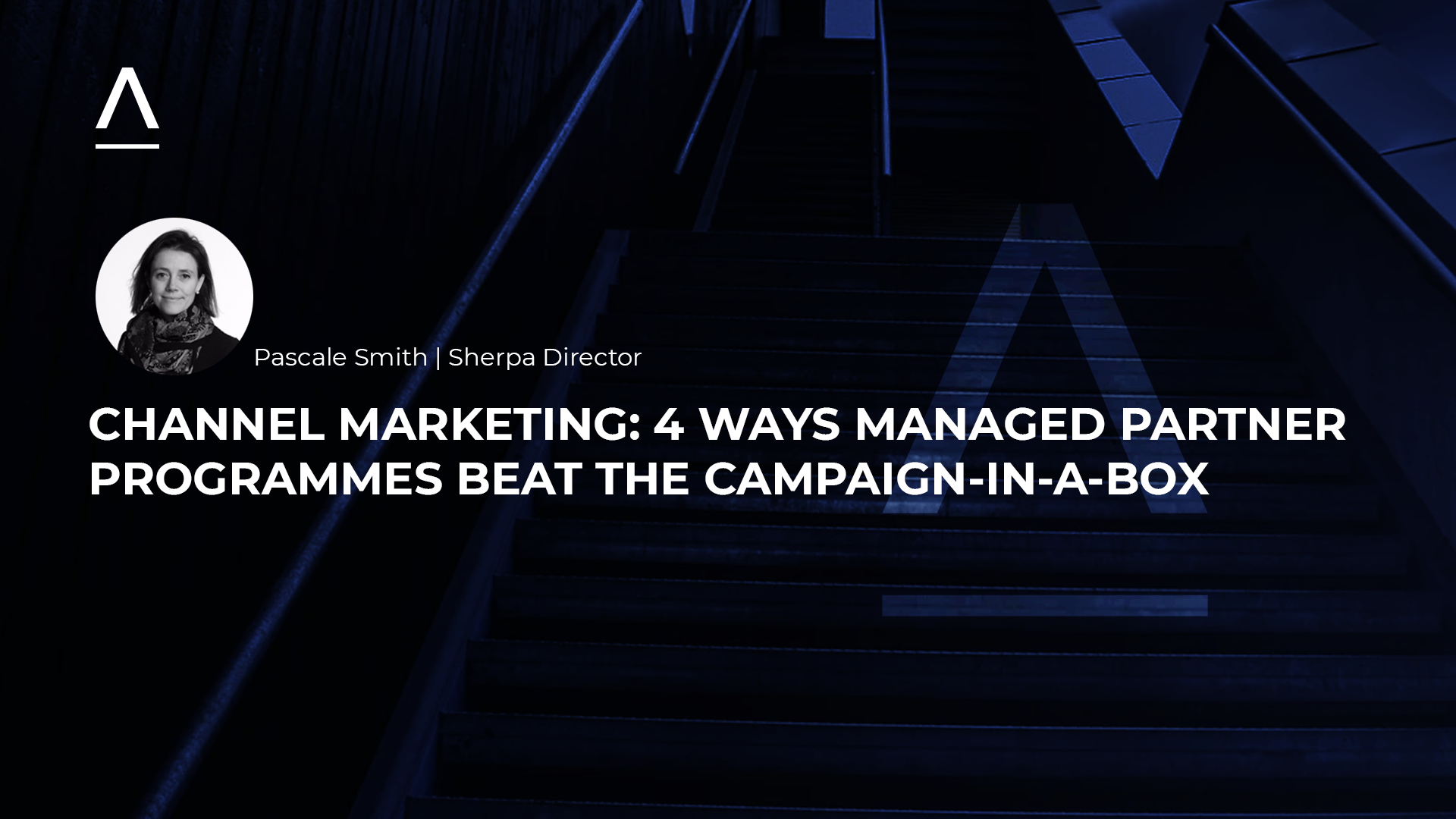
The demands made of channel Partner marketing are significant: it needs to scale, demonstrate ROI, generate revenue (often within a quarter), reflect...
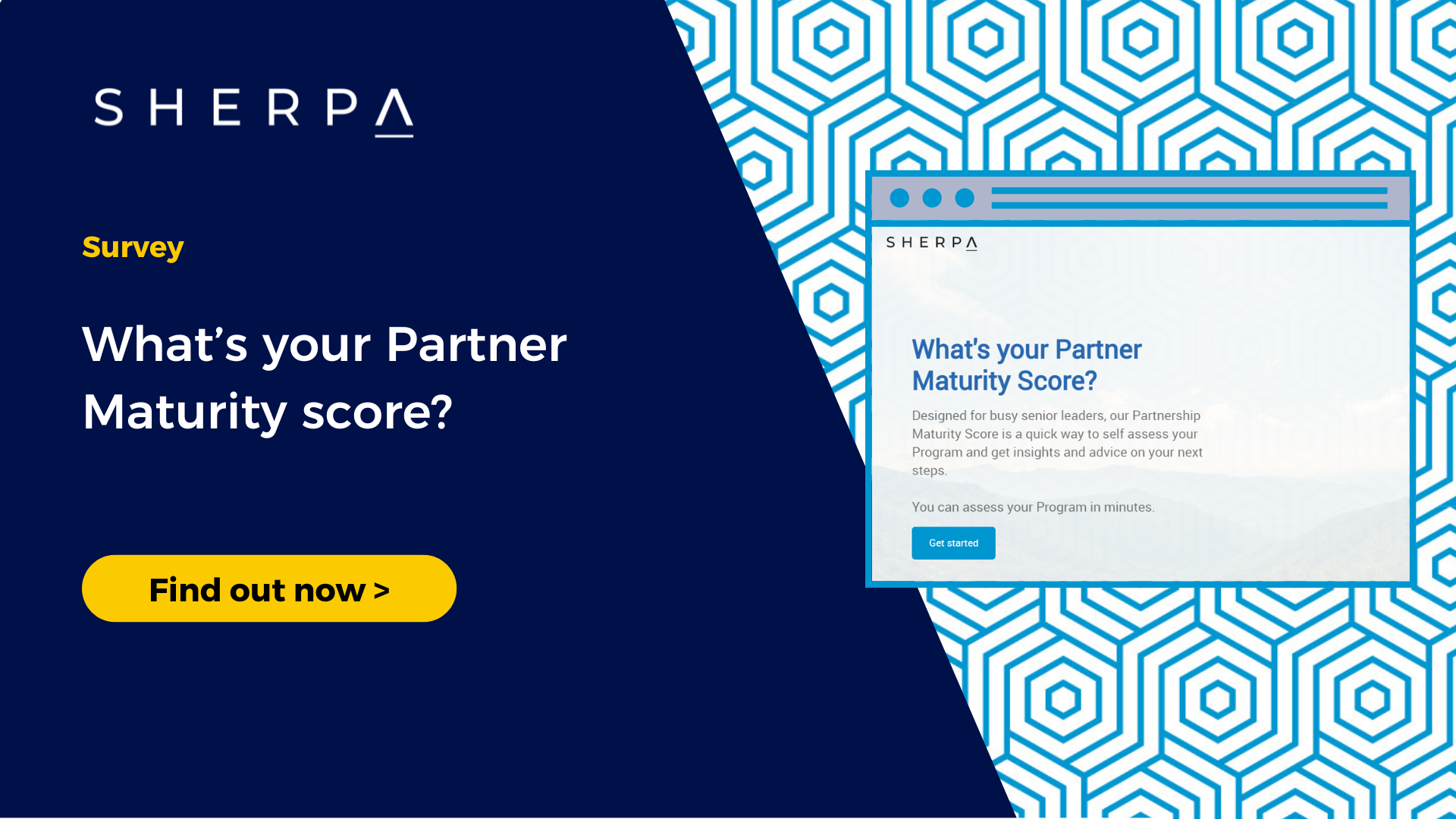
Are you struggling to plan marketing activities in a complex Partner Marketing environment? Do you need to grow and drive more revenue but aren’t...